Global high-mix volume high-speed Shenzhen PCBA manufacturer

Ru
9:00 -18:00, Mon. - Fri. (GMT+8)
9:00 -12:00, Sat. (GMT+8)
(Except Chinese public holidays)





Global high-mix volume high-speed Shenzhen PCBA manufacturer

Ru
9:00 -18:00, Mon. - Fri. (GMT+8)
9:00 -12:00, Sat. (GMT+8)
(Except Chinese public holidays)





HomePage > Blog > Knowledge Base > Overview of PCB Breakaway Tabs
Not every part of a circuit board ends up in the final product. Some are temporary by design, like the small tabs on the edges of the board. These tabs don't carry current or hold components.
We are talking about PCB breakaway tabs—tiny connectors that hold boards together during production. If you have ever snapped a small circuit board out of a larger panel, you have seen them in action. Maybe you didn’t notice. That’s the point.
In this blog, we will discuss everything you need to know about PCB breakaway tabs. Let’s break them down.
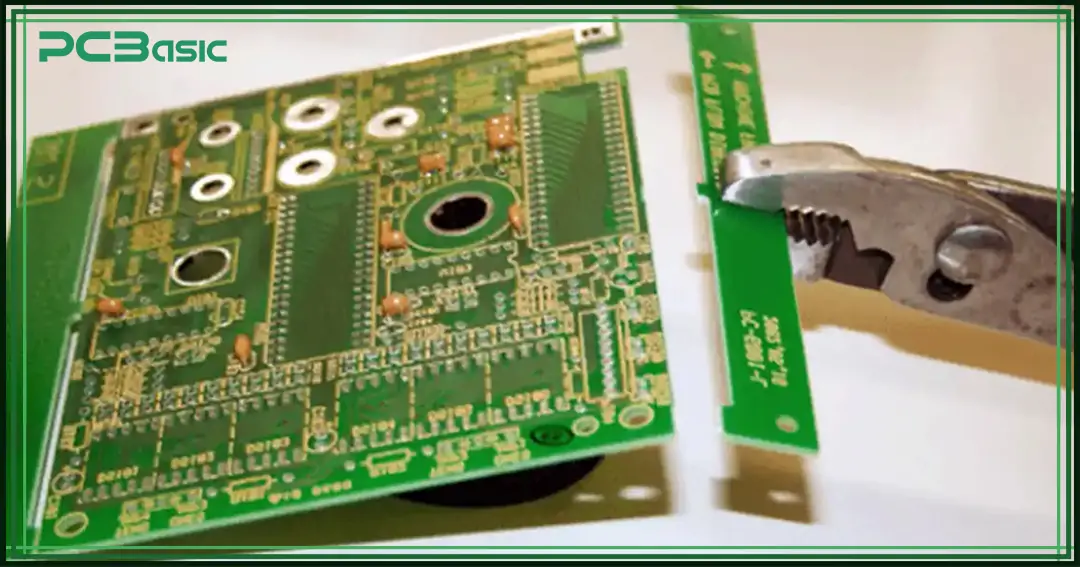
Breakaway tabs are small bridges of material left between PCBs during panelization. They keep multiple circuit boards together as one unit through manufacturing. Once the boards are assembled, tested, and reflowed, the tabs get snapped off. Clean separation. Minimal stress.
There are different types. Some use mouse bites—a row of small drilled holes that make snapping easier. Others use V-scores—grooved lines scored into the board surface for clean, straight breaks. They are not part of the circuit. But they are part of the process. Essential for keeping boards aligned and manageable on the production floor. In short? They’re sacrificial. And they make the rest of your PCB’s life easier.
There are several ways to design breakaway tabs, each suited to different needs. Here are the most common:
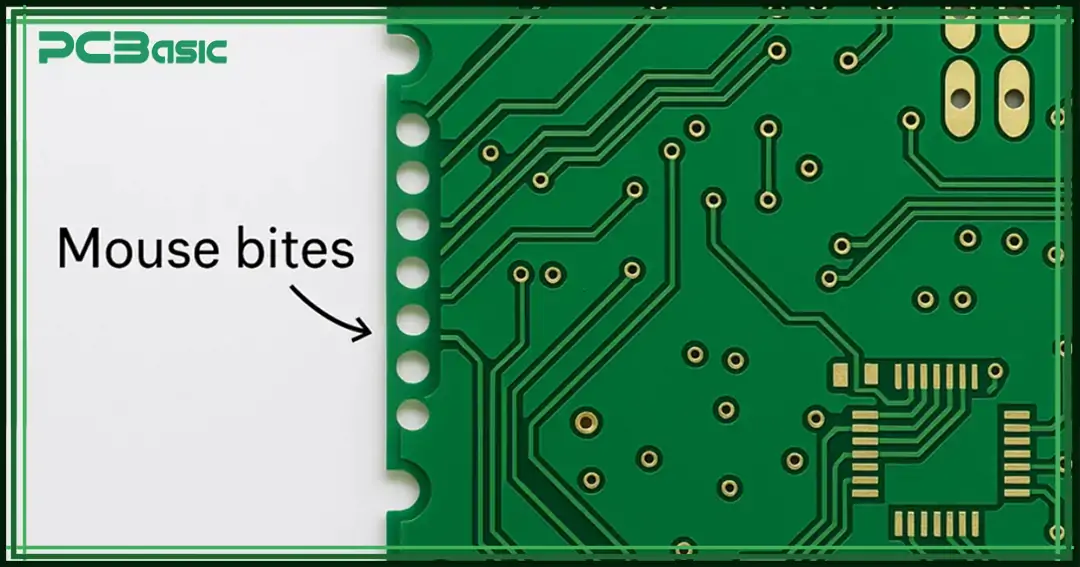
This is the most widely used type. A solid tab connects PCBs in the panel, and a row of small drilled holes—called mouse bites—makes it easier to break the tab off after assembly. Think of it like the perforation on a ticket stub. After assembly, the tab can be snapped off cleanly. It's fast and low-cost.

In this method, a shallow "V" groove is cut into both sides of the PCB surface. It leaves just a thin strip of material in the middle. After assembly, the board can be snapped along the score line. V-scoring is often used when a clean edge is required, as it leaves minimal residue.
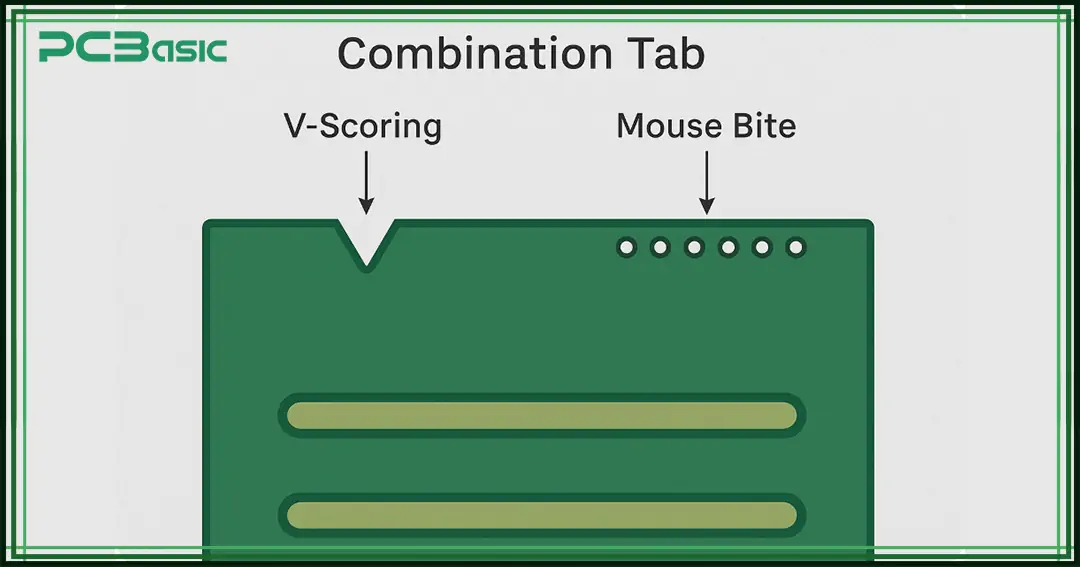
Some panels use both mouse bites and V-scoring. This allows for even cleaner separation, especially in automated depaneling processes.
Each method has trade-offs. Mouse bites are easy to implement but may leave rough edges. Scored tabs provide cleaner edges but may need extra handling.
Why use PCB breakaway tabs at all? Can’t you just manufacture boards individually? Technically, you can. But it’s not efficient.
Here are the key advantages:
● Efficient handling: Panels are easier to load onto assembly machines than individual small boards.
● Reduced cost: Shared panelization saves on material, labor, and machine time.
● Lower damage risk: During transport and reflow, small boards can shift, bend, or break. Tabs hold everything in place until the very last step.
● Improved throughput: Breakaway tabs allow multiple boards to be processed in a single pass.
● Scalable: Whether you are running 10 boards or 10,000, breakaway tabs keep things streamlined. They work for quick prototyping and full-scale production alike
For contract manufacturers and OEMs, these benefits translate into better margins and faster turnaround times.

So, how are breakaway tabs PCB designs handled during manufacturing? Here’s the typical workflow:
Panels with breakaway tabs are loaded onto pick-and-place machines. The full panel is treated as a single unit. This allows components to be placed quickly and consistently across all the boards in the panel.
During reflow, the tabs help maintain structural stability. No need to worry about tiny boards shifting or warping inside the oven.
After inspection and testing, the boards need to be separated. This is known as depaneling.
There are two common ways:
● Manual depaneling: A technician snaps the boards apart by hand or uses cutting tools like depaneling pliers or cutters. It’s common in low-volume or prototyping setups.
● Automated depaneling: High-volume factories use routers or dedicated machines to remove tabs cleanly. This ensures consistent edge quality.
If mouse bites are used, the board might have a slightly rough edge. This can be filed or sanded smooth if needed.
Designers can control where the breakaway tabs are placed. This depends on factors like:
● Component layout
● Board stress tolerance
● Final product casing
Tabs should be positioned to avoid damaging traces or sensitive areas during depaneling. Most PCB design tools allow users to insert mouse bites or V-scores easily into panelized layouts.
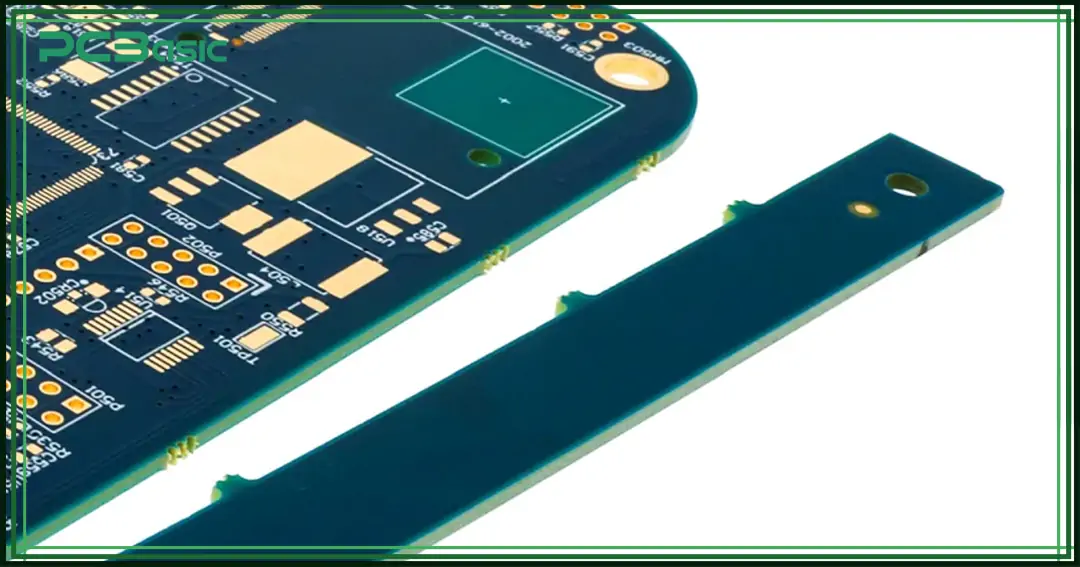
Adding breakaway tabs isn't something you do at the last minute. Good panelization planning starts early in the design process.
Here are a few key things to consider:
● Tab size and placement: Tabs should be strong enough to hold the board but not too tough to break. Avoid placing them near delicate components.
● Clearance zones: Allow space for router bits or depaneling tools to work without hitting parts or traces.
● Stress distribution: Spread tabs evenly around the board to avoid flexing or cracking during snap-off.
● Edge quality: Know if you need post-processing (filing or sanding) after depaneling.
If you are designing for automated depaneling, talk to your manufacturer early. They might have specific requirements for spacing, hole size, or tooling paths.
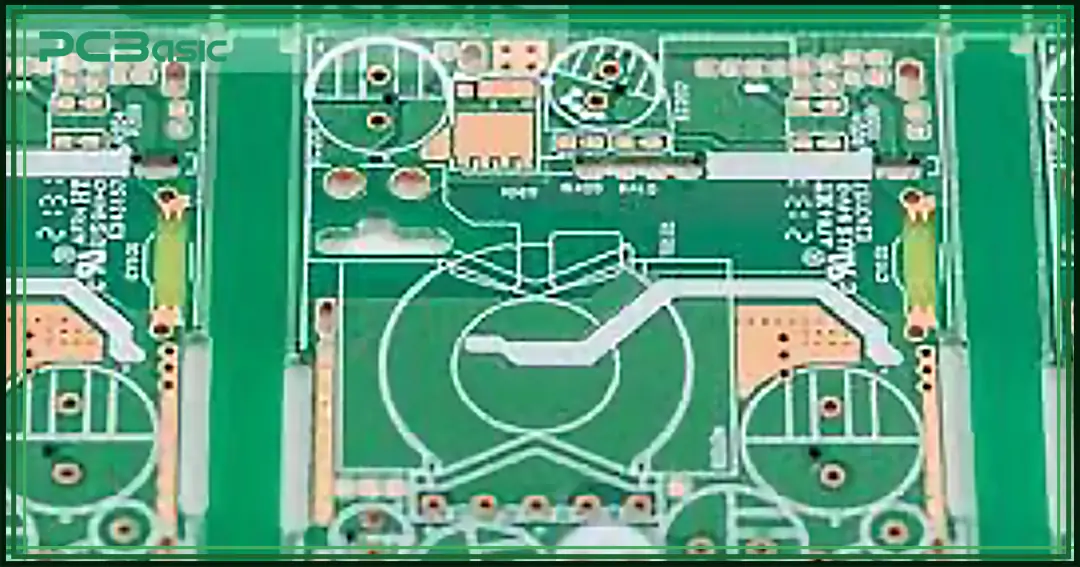
At PCBasic, panelization isn’t an afterthought. It’s a core part of our PCB manufacturing process. We design with the full production cycle in mind—from layout to final break-off.
Our engineers work closely with customers to determine the right type of breakaway tabs. Whether it’s mouse bites or V-scoring, we focus on speed and quality. No compromises.
Mouse bites are still the top pick, especially for prototypes and short runs. They are quick, cost-effective, and require no special routing. For higher-end products or where edge quality matters more, we lean toward scoring or combined methods.
Each board type is evaluated for:
● Size and thickness
● Component density
● Fragility of layout
● Required edge smoothness
● Method of depaneling
This ensures the tabs match the board's actual use case, not just the standard template. We also prioritize panel strength. Some boards need extra rails or support tabs to avoid bowing or warping during reflow. In those cases, extra material is added to the edges—still removable, but stronger.
One common issue with breakaway tabs PCB designs? Rough edges. Especially when using mouse bites.
After snapping, the leftover stubs from the perforation can stick out. It's not a problem for all applications—but if your board goes into a tight-fitting case, you’ll notice.
PCBasic offers optional edge finishing. We use sanding wheels or mechanical routers to smooth down mouse bite remnants. This creates a more polished and professional edge. It also prevents sharp burrs from causing fitment issues or damaging plastic enclosures.
For boards with V-scoring, the separation is usually cleaner. But even then, a light sanding pass can make the difference between “functional” and “production-grade.” Some customers opt to handle edge cleanup in-house. Others prefer it done before shipping. Either way, it’s good to plan for this step if your design has strict size tolerances.
Different projects need different workflows. Some engineers design their boards to be snapped off by hand. It's fast, easy, and cost-saving, especially for small runs or DIY electronics.
Others work in high-volume environments where manual depaneling is too slow—and too risky. That’s where automated depaneling comes in.
PCBasic supports both. For manual processes, we recommend mouse bites and accessible tab placement. The goal is to make snapping safe and easy without damaging components.
For automation, we take a different route:
● Add precise V-scores at calculated points
● Design clearance zones for routing tools
● Mark fiducials for optical alignment. While used mainly during assembly, they also help some depaneling systems align cuts accurately.
● Use stronger rails or frames to support the panel during machine separation
We also help customers decide if router-based depaneling or laser depaneling is better suited for their needs. Both methods have trade-offs in cost, time, and cleanliness.
Laser depaneling, for instance, is non-contact and extremely precise—but expensive. However, it requires precise thermal control to avoid damaging nearby components. Mechanical routing is more common and more affordable.
Either way, the breakaway tab design needs to match the depaneling method from the start. Changing it later adds risk and rework.
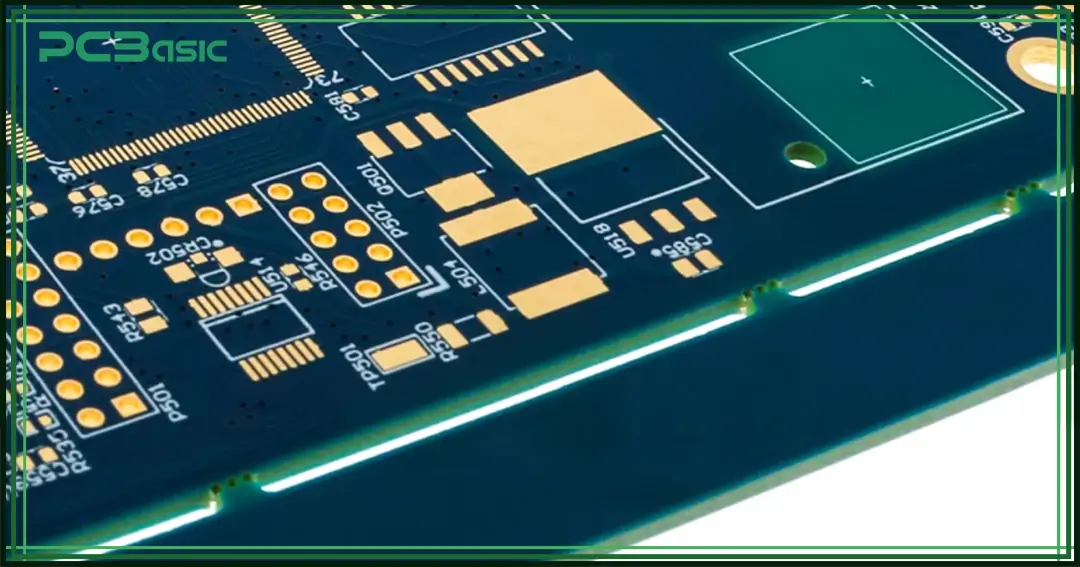
PCB breakaway tabs are small, but they play a big role in the production process.
They hold boards together during handling, simplify panelization, and reduce manufacturing costs. Whether it’s a basic mouse bite tab or a precision V-scored groove, the right choice depends on your product’s needs.
Breakaway tabs PCB designs allow for easier assembly, lower waste, and scalable production. But it’s not just about choosing a tab type. Good results come from thoughtful planning—placement, strength, tooling clearance, and finishing all matter.
At PCBasic, we don’t treat breakaway tabs as an afterthought. We build them into your design from day one. Our engineers help configure the right layout for your board and your budget. Whether you need simple snap-off panels or high-volume automated depaneling, we’ve got the experience to do it right.
And if you’re unsure which tab method to use—mouse bites or scoring—just ask. We’ll help you design for manufacturability without compromising performance.
In PCB manufacturing, it’s often the little things that count. Breakaway tabs are one of those things. Small. Invisible in the final product. But absolutely essential to getting there.

Assembly Enquiry
Instant Quote